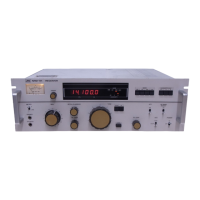4.2.6
FurtherOperation
(
I
)
Operation
of ATT.
The
receiving antenna
catches
many kinds
of
radio wave from
the strong
one
to weak
one.
If many strong waves arrive at the high frequency stage
of
the
receiver,
interferences such as
intermodulation,
blocking,
cross-modulation and
so
on
arise, so
that sometimes
the desired radio waves cannot be received
well. Also, when
the
partner
station is
located very
close
to
your
station,
the
sound
is distorted because
the
AGC
circuit cannot
control
such a strong
radio
wave.
In
such a
case, by setting
J
,Â1T
I
to
N,
the
receiving
condition
is
greatly
improved. If
p
meter deflects,
the desired
radio wave can
be received
even
though
l-AT1-l
is set to
trt.
Especially,
when
receiving the
radio wave below
1.6 MHz,
it is recommended to always set
IATTI
to
@
except
at the
stand-by condition.
(2)
Operation
of BC BAND
REJECT
While
receiving
the MHF
band
(below
3 MHz), many other radio waves may be received
besides the
radio wave
of the desired station. These
are
called
cross-modulation
and
intermodulation
interferences due
to
the
strong radio wave of
the broadcasting wave
(525
to
1605
kHz). In
such
a condition, by setting
BC
BAND
REJECT switch to
@,
an
eliminator
filter
located at
the
ANT
input
circuit
operates so
as
to reject such
interferences,
so
that the receiving condition
will be remarkably improved. When the
desired wave
is
comparatively
strong,
use
the above-described
IATT-I
together with
BC BAND
REJECT
(3)
Operation
of AGC
switch
The
discharging
time constant
at the
position
of AGC
tSLôVln
is set to 3 sec.
so
as to
suppress
the noise
between
communications
in SSB
mode enough
for the
pleasant
communication.
When
receiving
the
radio wave affected
by moderate
fading,
the
ISLOW
I
position
seems
to
give
better
result.
However,
the weak
signal
promptly
after
that the strong
signal
is received may not
be
able
to hear since
the
gain
is not recovered
yet.
Therefbre, when
communicating
with
the
ship at a
far distance
and the one at a near distance
by turns, set
the
l-ÂGCl
switch
to
fF-Àsr-].
€5?*rl
ïeû4_
lri,.rb
i;
f
||,r''h'{3
#\
i7
Ëi
s
6
\fsff
't
*\:$f
'!:
.r
il
i
|
*.
^ 4 ir if
| 5'li lr
t-
.
*r
t-
-
t5
-

